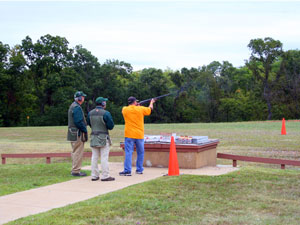
 The small group of mallards hardly reacted to the shot, which means I wasn't even close. The stinging of missing a nice plump greenhead at very close range was bad, but the ribbing I had to take from the other inhabitants of the duck blind was much worse. I swore on that day I would get my revenge.
The small group of mallards hardly reacted to the shot, which means I wasn't even close. The stinging of missing a nice plump greenhead at very close range was bad, but the ribbing I had to take from the other inhabitants of the duck blind was much worse. I swore on that day I would get my revenge.
My revenge it seemed was much closer than I imagined and not nearly as difficult. Three easy steps had me shooting like a pro.
"Shotgun shooting isn't like riding a bike," says Jake Hindman, a certified Effective Wingshooting for the Hunter instructor. "If you want to be proficient, you need to shoot regularly."
While participating at this course using techniques utilized by the Cooperative North American Shotgun Education Program (CONSEP), a partnership of state wildlife agencies and ammunition companies to help hunters become more proficient using non-toxic shot, Hindman talked about the shooting range of waterfowl hunters. "The average waterfowl hunter cannot break six of eight clay targets at 20 yards, which means that most hunters are shooting 30-40 yards beyond their effective range."
As I watched another unbroken orange bird sail off, I thought about those numbers.
Butt, Belly Beak, Bang
Finally, after watching me blast through a half a box of shells without hitting a single target, Hindman suggested I try something different. He introduced me to a system known as "butt, belly, beak and bang."
"Swing behind the bird (butt), catch up to it (belly) and begin accelerating past the bird (beak), continue to follow through until you establish a lead and finally slap the trigger (bang)." said Hindman.
To my surprise, the bird disappeared in an orange puff. After successfully hitting six birds in a row, I began feeling pretty good about my shooting skills and was ready to head to station two.
Range Estimation
According to Hindman, "The first shot fired at a flying duck is taken at 53 yards; a long way for even the most seasoned waterfowler and on geese the first shot fired is at a distance of 67 yards. This explains why the crippling rate on waterfowl is so high; 25 percent which equates to one bird in four hit by a pellet strike not being recovered." CONSEP hosts training in 23 states to help hunters reduce this statistic.
Although a rangefinder is nearly impossible to use on flying birds, marking a known marker and waiting for the birds to come into that marker is one sure fire method of having the birds in range. Another method is called subtending — a flying decoy or silhouette is mounted on a pole at a known distance, the shooter uses the end of their shotgun barrel to determine how much of the decoy is covered up with the gun barrel.
"Soon you will have an idea of what a bird within range actually looks like," says Hindman.
Pattern Your Shotgun
"Most hunters spend far too little time patterning their shotgun," said Hindman. "A few shots at a patterning board will answer many questions like how many pellets a particular load is delivering at your comfortable shooting distance."
Range time during the pre-season is the time and place to try different chokes and loads — both different brands and shot sizes. While it is true it may only take one pellet to make a clean kill, there needs to be ample amounts of pellets to deliver that one.
Tom Roster, noted shotgun ballistician and consultant with CONSEP, has created a table listing not only the minimum number of non-toxic pellets needed within a 30-inch circle to deliver a clean kill, but the minimum payload of shot, recommend chokes and pellet size for many waterfowl and upland game birds in an array of situations.
Thanks to the methods of CONSEP, no longer will I be the laughing stock of the duck blind; at least not because of my shooting.
Below is a link from the Texas Parks & Wildlife Waterfowl regulations featuring Roster's chart.
- 6061 views

